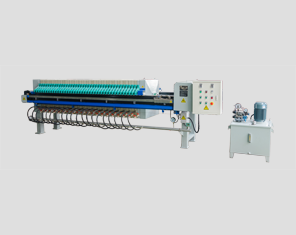How much do you know about the structure and working principle of the filter press?
What is a filter press?
A kind of mechanical equipment that uses a special filter medium to exert a certain pressure on the object, so that the liquid is dialyzed out. The solid in the mixed liquid is extracted to achieve the effect of solid and liquid separation.
Filter Press Application
Filter presses are widely used in pharmaceutical, chemical, standard parts, pharmaceutical, metallurgy, dyestuff, food, brewing, ceramics, oil refining, sewage treatment and other environmental protection industries.
Filter press classification
Classified according to filtration method: box filter press, plate and frame filter press, belt filter press, diaphragm filter press;
According to the structure classification: cantilever beam filter press and belt filter press;
Classified according to the pressure method: hydraulic compression, manual jack compression, mechanical compression.
How does a filter press work?
The filter press is generally composed of a head plate, a tail plate, a filter plate, a hydraulic cylinder, a main beam, a transmission and a pulling device. The mud pump sends the mud into the filter chamber, the water permeates the filter cloth and is discharged through the liquid discharge port, and the solid mud forms a filter cake in the filter chamber. Separation in the filter.
Step 1: Press the filter plate
Operate the hydraulic system to move the tail plate to the direction of the head plate, and press all the filter plates between the head plate and the tail plate. Thus, a hollow sealed filter chamber is formed between the adjacent filter plates.
Step 2: Filter Press Process
The feeding pump transports the mud from the feeding hole of the tail plate to the filter chamber. When the filter chamber is filled with mud, the filter press process starts, and the mud is separated from solid and liquid by the pressure of the feeding pump.
In the initial stage of filtration, the thickness of the filter cake in the filter chamber is not large, the resistance of the filter cake is small, and the dehydration speed is fast. Usually, a pump with low head and large flow is used at this time. As the thickness of the filter cake increases, the resistance increases and the pressure When the filtration speed drops, a pump with high lift and small flow is used. The time required for the filter press process is determined according to the filter characteristics and process requirements of the mud. When the specified filter press time is reached, the feeding is stopped and the filter press process is completed.
Step 3: Loosen the filter plate
Operate the hydraulic system to return the head plate to its original position.
Step 4: Filter plate unloading
The transmission chain on the transmission and pull-open device pulls the filter plate apart one after another, and the filter cake falls off by its own weight and is transported away by the lower conveyor.
Factors Affecting Performance
pressure
The main factor affecting the filtering effect of the filter press is the pressure control. As we all know, the main working principle of the filter press is to realize the filtering function through the control and adjustment of the pressure, so the quality of the pressure system is directly related to the filtering effect. Good or bad.
speed
Another factor that affects the performance of the filter press is the speed of filtration. Now many manufacturers are blindly pursuing the speed of product filtration and ignoring the essence of filtration. In fact, it should be considered and appropriate according to different factors such as the concentration and resistance of the liquid. Allocate the use speed of the machine, which the designer needs to design before purchasing.
filter area
The factors that affect the filtering effect of the filter press also include the area of the filter. As we all know, the larger the area of the filter, the faster the flow of objects passing through, the more residues will be taken away from it, and the worse the filtering effect will be. Of course, between the same density specifications, the large area is not as good as the small area filter, but this comparison method on the products with different mesh areas is not applicable.
Structure and working principle of stacked screw filter press
Structure: The main body of the dehydrator is a filter device formed by stacking a fixed ring and a moving ring, and the screw shaft runs through it. The front section is the concentration section, and the rear section is the dehydration section. The pitch of the slit and the screw shaft gradually decreases from the thickening part to the dewatering part. The rotation of the screw shaft pushes the sludge to be transported from the thickening part to the dewatering part, and also drives the swimming ring to clean the filter slit to prevent clogging.
working principle:
1. Concentration: When the screw push shaft rotates, the multiple fixed and movable laminations located on the periphery of the push shaft move relatively, and under the action of gravity, the water is filtered out from the relatively moving lamination gap to achieve rapid concentration.
2. Dehydration: the concentrated sludge moves forward with the rotation of the screw shaft; along the outlet direction of the mud cake, the pitch of the screw shaft gradually becomes smaller, the gap between the rings also gradually becomes smaller, and the volume of the spiral cavity gradually becomes smaller. Continuously shrinking; under the action of the back pressure plate at the outlet, the internal pressure gradually increases, and under the continuous operation of the screw shaft, the water in the sludge is squeezed and discharged, and the solid content of the filter cake is continuously increased, and finally the sludge is realized. continuous dehydration.
3. Self-cleaning: The rotation of the screw shaft drives the moving ring to rotate continuously, and the equipment relies on the movement between the fixed ring and the moving ring to realize a continuous self-cleaning process, thus cleverly avoiding the common clogging problem of traditional dehydrators.

Related News
- Filtration principle and operation of plate and frame filter press
- Different matters that should be paid attention to in the use of the filter plate of the diaphragm filter press
- What is the influence of the working period of the diaphragm filter press?
- The reason for the leakage of the box filter press
- Filter bag replacement and pressure condition of super essential oil filter
- The particularity of filter cloth used in plate and frame filter press
- What is the pressing principle of the diaphragm filter press?
- Introduction to filter maintenance
- What is the filtration speed, operation method and development direction of the filter?
- What is the impact of pump selection and insufficient pressure in filter presses?
- Advantages and disadvantages of plate and frame type, horizontal disc type and candle type diatomite filter?
- Talking about the relationship between water inflow and water outflow of high-pressure diaphragm filter press
- Why is the filter plate of the filter press easily damaged?
- The reason why the filter belt of the sludge filter press is not clean
- How to choose a plate and frame filter press for small and medium-sized enterprises
- Why not use a box filter press at night?
- How does a soy sauce press work?
- What are the steps of belt filter press dehydration?
- Operation specification and use method of sludge filter press
- Analyze the heating problem of the diaphragm filter press


